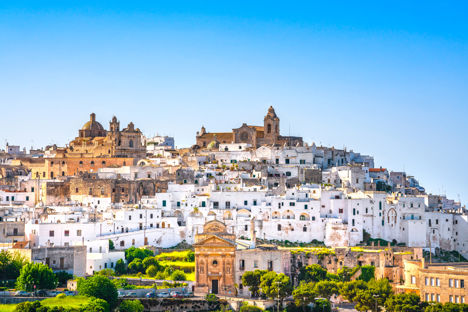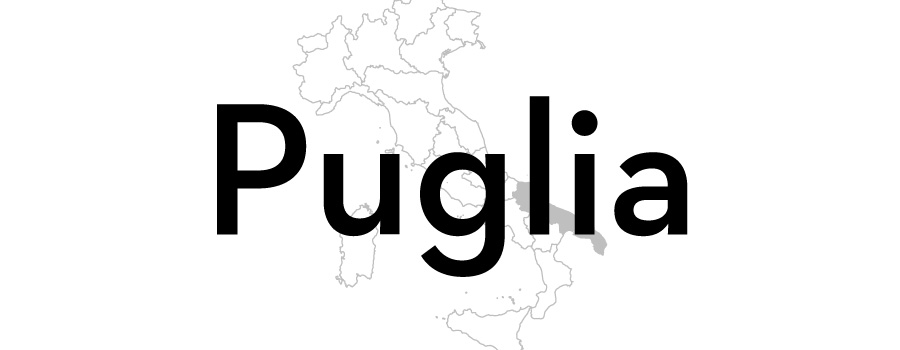
The complete foodie guide to Puglia
Puglia is responsible for producing the vast majority of Italy’s olive oil and durum wheat, but there are also wild greens, fresh mussels, simply cooked lamb and some incredible bread to get your teeth stuck into. Get to know exactly what to look out for in this beautiful southern region with our handy guide.
The complete foodie guide to Puglia
Puglia is responsible for producing the vast majority of Italy’s olive oil and durum wheat, but there are also wild greens, fresh mussels, simply cooked lamb and some incredible bread to get your teeth stuck into. Get to know exactly what to look out for in this beautiful southern region with our handy guide.
Puglia is a region of farmers. The land is generally flat, with huge swathes of the countryside set aside for agriculture which produces over 40% of Italy’s olive oil. It’s also a huge producer of durum wheat, which has resulted in Puglia becoming the home of some of Italy’s most famous pasta dishes and breads.
The southern region has traditionally been a poor one, with cucina povera responsible for most Puglian dishes. Meat plays second fiddle to vegetables (although in more recent times it has become a lot more common), while fish and seafood are enjoyed along Puglia’s coast. Hearty baked dishes, simple plates of pasta and wilted wild greens such as chicory or cimi de rape are among the region’s most famous foods, while the rich string cheese burrata and bread from Altamura are enough to justify a direct trip to the area.
Take a look at the ingredients, flavours and dishes of Puglia to get a good grounding in the local cuisine. Whether you’re visiting the region or looking to recreate Pugliese cooking in your own home, you’ll be able to cook (and eat) like a local nonna in no time.
Ingredients and flavours
One of the finest examples of cucina povera cooking perhaps in all of Italy, grano arso is an ingredient born out of poverty that is now championed by Puglia’s top chefs. It is a type of flour made from burnt wheat, originally collected by locals after the vast durum wheat fields had been razed after the harvest. It has a nutty, earthy flavour, which is used to make breads and pastas, and is one of Puglia’s most famous products.
Various types of bread can be found across Puglia, but the most famous by far is the Pane di Altamura – the only bread in the world granted PDO-protected status. It’s made using specific varieties of wheat and local salt, water and yeast, and stays fresh for up to two weeks.
With so much wheat locally available, it’s no surprise that there are lots of pasta shapes associated with Puglia as well as breads. Orecchiette (‘little ears’) is by far the most famous (and you will genuinely see old women making them by the hundreds in Puglia’s streets), but there’s also troccoli (like a thicker spaghetti), sagne (rolled ribbons of fettuccine) and capunti (said to resemble open pea pods), among many others.
Vegetables are an incredibly important part of traditional Puglian cuisine, as meat and fish was often too expensive to eat on a regular basis. Cherry tomatoes are particularly prized in the region (as are olives and their oil – Puglia produces more olive oil than any other region), but more unusual ingredients include lampascione, a type of bitter bulb similar to an onion which grows deep underground, and barratiere (or carosello), local varieties of round cucumber. Cimi di rape (or broccoli rabe), a wild green similar in taste to broccoli, and wild chicory are also a common sight at markets, as are many different wild bitter greens. Vegetables are often preserved in oil and vinegar to be eaten in the colder months, a method known as sott’olio.
Lamb and goat is the most common meat in Puglia, although you’ll find horsemeat on restaurant menus as well. Meat is usually slow-cooked in wood-fired ovens to create stews or large roasted cuts to be carved at the table. Pork is more of a special occasion meat, although it is used to create local cured meats such as Cervellata Pugliese and Salsiccia di Lecce. You’ll not find that much beef in traditional recipes.
Mussels are the most common seafood eaten in Puglia, but along the region’s beautiful coast you’ll find all manner of fish and shellfish eaten. One unique speciality is Tarantello, a spiced air-dried loin made from tuna famously from Taranto, and you’ll also find plenty of simple dishes with octopus, cuttlefish, anchovies and white fish at their core.
Burrata has taken both Italy and the world by storm in recent years, despite only being invented in Puglia in the 1950s. Burrata di Andria is a local speciality which must be consumed within twenty-four hours of its production, and is well worth seeking out if you’re in the area. The historic shepherding culture of Puglia also means there are plenty of sheep’s cheeses in the region, the most famous of which is Canestrato Pugliese, a hard cave-aged cheese grated over pasta dishes. Keep an eye out for Cacioricotta too, which is like ricotta but sharper and slightly firmer.
Desserts in Puglia are almost always pastries made or flavoured with almonds, sweetened ricotta, honey or vin cotto di fiche, a thick sweet syrup made from figs and drizzled over dishes.
Puglia produces more wine than any other region in Italy, but it was traditionally a case of quantity over quality, with much of it sent to other regions to create blends. Today, however, winemakers in the area are respected in their own right, with full-bodied Primitivo reds particularly well-known. Local liqueurs are also enjoyed as a digestif, flavoured with bay leaves, pomegranates and myrtle berries.
Famous dishes
These little crunchy rings of baked dough are eaten like crisps in Puglia, often with a glass of red wine as an aperitivo. They’re often flavoured with fennel seeds, peppercorns or poppy seeds, and are incredibly moreish. You’ll find big bags of them sold across the region (and indeed, all of Italy).
Frise or friselle are one of Puglia’s most iconic foods, similar in appearance to a bagel but hard and crunchy like a biscuit. This is because they are double-baked (like biscotti) which improves their shelf life – perfect for labourers working in the fields or fishermen out on long trips. Before eating, they would simply soak the friselle in sea or spring water. When topped with fresh tomatoes, the friselle becomes friselle Salentina, a speciality of Salento.
We tend to think of calzone as a folded over pizza, but in Puglia it refers to a pie filled with onions, tomatoes, olives and anchovies. The variety of onions used makes all the difference, and in Puglia it tends to be either cipolle sponsali (resembling a leek) or local red onions, which are renowned for their sweetness.
Puglia’s most famous pasta dish is also a perfect example of the region’s love for cooking wild bitter greens. Cimi di rapa is also known as broccoli rabe, and has a pleasant bitter note when cooked. You’ll see this on restaurant menus across Puglia.
In Bari focaccia is an incredibly popular snack, and bakeries all over the city sell a version studded with tiny cherry tomatoes, olives and oregano. It’s best eaten fresh, which is why it’s baked throughout the day, as the aroma of a focaccia right out of the oven is impossible to walk past without wanting to buy a slice.
Salads which combine bread and tomatoes are abundant across Italy (the most famous being panzanella), but in Puglia acquasala is the most common interpretation. Slices of wet bread are rubbed with fresh tomatoes then sprinkled with salt, oregano and plenty of olive oil. Chopped onions are added along with more chunks of tomato. It’s a fantastically simple dish to prepare during the summer, although using the best, ripest tomatoes is key to its flavour.
An incredibly simple pasta dish which makes the most of Puglia’s prized sea urchins, often brought ashore in Taranto. The roe is stirred through freshly cooked pasta with white wine, garlic, olive oil, salt and sometimes a little chilli. When the sea urchins are as fresh as they are in Puglia, you don’t need to do much to them.
This unusual dish puts Pugliese mussels centre stage, baking them into a pie with rice, onions, tomatoes, potatoes and breadcrumbs. The mussels are left in their shell, which means you’ll need to pick them out, but it is traditional. The layered rice dish gently steams in white wine in the oven, with the crunchy breadcrumb topping providing plenty of texture.
Fava beans mashed into a purée with some wild chicory (or other greens) on the side. You’ll find versions of this dish throughout Italy, but it is particularly popular in Puglia. A good glug of local olive oil isn’t just suggested – it’s required.

